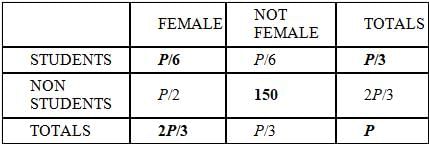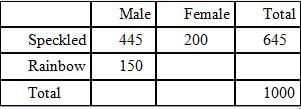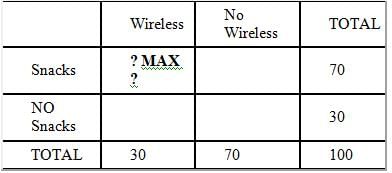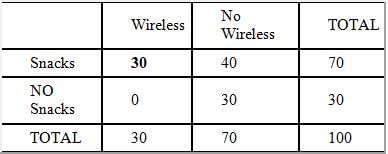Test: Overlapping SETS- 1 - GMAT MCQ
15 Questions MCQ Test - Test: Overlapping SETS- 1
Of the films Empty Set Studios released last year, 60% were comedies and the rest were horror films. 75% of
the comedies were profitable, but 75% of the horror moves were unprofitable. If the studio made a total of
40 films, and broke even on none of them, how many of their films were profitable?
the comedies were profitable, but 75% of the horror moves were unprofitable. If the studio made a total of
40 films, and broke even on none of them, how many of their films were profitable?
At a certain hospital, 75% of the interns receive fewer than 6 hours of sleep and report feeling tired during
their shifts. At the same time, 70% of the interns who receive 6 or more hours of sleep report no feelings of
tiredness. If 80% of the interns receive fewer than 6 hours of sleep, what percent of the interns report no
feelings of tiredness during their shifts?
their shifts. At the same time, 70% of the interns who receive 6 or more hours of sleep report no feelings of
tiredness. If 80% of the interns receive fewer than 6 hours of sleep, what percent of the interns report no
feelings of tiredness during their shifts?
| 1 Crore+ students have signed up on EduRev. Have you? Download the App |
All of the students of Music High School are in the band, the orchestra, or both. 80 percent of the students
are in only one group. There are 119 students in the band. If 50 percent of the students are in the band only,
how many students are in the orchestra only?
are in only one group. There are 119 students in the band. If 50 percent of the students are in the band only,
how many students are in the orchestra only?
How many attendees are at a convention if 150 of the attendees are neither female nor students, one-sixth of
the attendees are female students, two-thirds of the attendees are female, and one-third of the attendees are
students?
Eighty percent of the lights at Hotel California are on at 8 p.m. a certain evening. However, forty percent of
the lights that are supposed to be off are actually on and ten percent of the lights that are supposed to be on
are actually off. What percent of the lights that are on are supposed to be off?
Of the 645 speckled trout in a certain fishery that contains only speckled and rainbow trout, the number of
males is 45 more than twice the number of females. If the ratio of female speckled trout to male rainbow
trout is 4:3 and the ratio of male rainbow trout to all trout is 3:20, how many female rainbow trout are there?
30% of major airline companies equip their planes with wireless internet access. 70% of major airlines offer
passengers free on-board snacks. What is the greatest possible percentage of major airline companies that
offer both wireless internet and free on-board snacks?
In country Z, 10% of the people do not have a university diploma but have the job of their choice, and 25%
of the people who do not have the job of their choice have a university diploma. If 40% of the people have
the job of their choice, what percent of the people have a university diploma?
Seventy percent of the 800 students in School T are male. At least ten percent of the female students in
School T participate in a sport. Fewer than thirty percent of the male students in School T do not participate
in a sport. What is the maximum possible number of students in School T who do not participate in a sport?
75% of the guestrooms at the Stagecoach Inn have a queen-sized bed, and each of the remaining rooms has
a king-sized bed. Of the non-smoking rooms, 60% have a queen-sized bed. If 10% of the rooms at the
Stagecoach Inn are non-smoking rooms with king-sized beds, what percentage of the rooms permit smoking?
At the end of the day, February 14th, a florist had 120 roses left in his shop, all of which were red, white or
pink in color and either long or short-stemmed. A third of the roses were short-stemmed, 20 of which were
white and 15 of which were pink. The percentage of pink roses that were short-stemmed equaled the
percentage of red roses that were short-stemmed. If none of the long-stemmed roses were white, what
percentage of the long-stemmed roses were red?
Some of the people in Town X are left-handed, some are tall, some are both, and some are neither. In Town
Y, three times as many people are left-handed as are left-handed in Town X, three times as many people are
tall as are tall in Town X, three times as many people are both as are both in Town X, but no one is neither. If
the total number of people in Town X is four times greater than the total number of people in Town Y, which
of the following could be the number of people in Town X who are neither left-handed nor tall?
The waiter at an expensive restaurant has noticed that 60% of the couples order dessert and coffee.
However, 20% of the couples who order dessert don't order coffee. What is the probability that the next
couple the waiter seats will not order dessert?
50% of the apartments in a certain building have windows and hardwood floors. 25% of the apartments
without windows have hardwood floors. If 40% of the apartments do not have hardwood floors, what
percent of the apartments with windows have hardwood floors?
A farmer has an apple orchard consisting of Fuji and Gala apple trees. Due to high winds this year 10% of his
trees cross pollinated. The number of his trees that are pure Fuji plus the cross-pollinated ones totals 187,
while 3/4 of all his trees are pure Fuji. How many of his trees are pure Gala?









 The correct answer is E.
The correct answer is E.













































